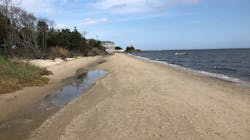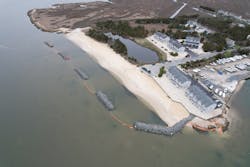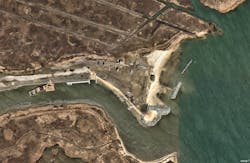Reviving Little Egg Harbor’s beaches: A story of erosion, restoration & resilience
Little Egg Harbor Township in New Jersey, often dubbed the “Little Treasure on the Bay,” has a history dating back to 1740. However, it remained mainly rural until the 1950s, when seasonal cottages were developed on artificial lagoons, which opened approximately 850 acres of previously undeveloped land, creating thousands of properties with access to water. By the 2000s, the population had grown significantly with the addition of several senior communities. Over time, the waterfront bungalows have been replaced by larger homes elevated above FEMA base flood elevation, many of which have become year-round residences. This 47.3 square-mile township, divided by the Garden State Parkway, is now home to over 20,000 residents, with extensive water bodies like Great Bay and Barnegat Bay covering a large portion and 24% designated as wetlands.
Amidst this historical backdrop, nestled on the picturesque New Jersey shoreline, Little Egg Harbor’s Mystic and Parkertown beaches have long been cherished by locals and visitors alike. However, in recent years, these once-expansive sandy havens have faced a relentless challenge — coastal erosion.
The need for a comprehensive restoration project became evident as the tides encroached, diminishing the shorelines. The Mystic Beach & Parkertown Beach Breakwaters and Beach Replenishment project picked up last October and wrapped up this June. The total combined project cost was $2.6 million, which the township paid for.
The Genesis of the project: A fight against erosion
Mystic and Parkertown beaches boasted considerable size and popularity in their heyday. A local haven for enjoyment, these beaches provided a scenic backdrop as the community blossomed in the 1960s. Yet, as time passed, erosion from the inlet took its toll. During high tide, a mere few feet of beach remained in recent years, starkly contrasting their former grandeur. Recognizing the need for intervention, Little Egg Harbor sought to restore these beloved beaches to their 1977 shorelines, a pivotal undertaking to improve marine habitats, safeguard uplands, and mitigate wave attenuation. Stevens Institute of Technology conducted comprehensive erosion studies and wave analyses to address these challenges. The goal was to recommend effective restoration measures, culminating in the design of breakwaters and jetties at both locations, a collaborative effort involving both New Jersey Institute of Technology and T&M Associates. These strategically positioned structures would work to stabilize the sandy shorelines, curbing the relentless erosion that had plagued these beaches for years.
The resilience measures executed at both project sites included various components such as breakwater design and coastal engineering, the construction of jetties, the creation of living shorelines planted with spartina aquatic plant species and oyster spat material, beach replenishment, and the replacement and restoration of tidal marshes. T&M Associates also added 12,000 cubic yards of sand at Mystic Beach to restore the shoreline to 1977 levels. To ensure compliance with diverse state and federal regulations, T&M Associates closely coordinated with various state and federal entities like the New Jersey Department of Environmental Protection’s Division of Land Resource Protection and the state agency’s Shellfish Council, the U.S. Army Corps of Engineers, U.S. Fish and Wildlife Service (USFWS), the National Marine Fisheries Service, Edwin B. Forsythe Wildlife Refuge, and shellfish lease owners in the area. These projects also involved vital wetland mitigation and monitoring, threatened and endangered species monitoring, and shellfish restoration initiatives, including using oyster spat material in collaboration with ReClam the Bay.
Turning visions into reality
T&M Associates handled the permitting process, managed the bidding, and oversaw the project’s construction from inception to completion. Their involvement was not limited to project management; it extended to encompass construction management, ensuring that every aspect of this crucial restoration was executed precisely.
The design process incorporated breakwaters and jetties that were carefully placed to effectively disrupt the current and sediment transport. Breakwaters were set above the main tide level, ensuring visibility to boaters and functionality during storm events with higher sea levels and surges. These structures were designed to create a “flushing” effect between the breakwaters and the beach, facilitating the buildup of new sand behind them and rejuvenating the beachfront.
Sustainability and habitat restoration
Intricately woven into these restoration efforts were initiatives to promote sustainability and enhance local habitats. The restoration of marshes and the planting of native spartina species played a crucial role in fortifying these ecosystems. The project team worked closely with ReClam the Bay; an organization dedicated to restoring Barnegat Bay’s shellfish populations.
As part of these efforts, oyster spat material created living shorelines. This involved placing oyster shells in bags and positioning them between the rocks on the jetties. These shells are a foundation for oyster larvae to attach and grow, effectively cultivating new oyster habitats along the rocky structures. This not only promotes marine life but also contributes to the resilience of the local ecosystem.
The journey towards reviving Mystic and Parkertown beaches was challenging. Permitting, a notoriously time-consuming aspect of such projects, demanded close collaboration with various regulatory agencies. Ensuring that the project met the approval of adjacent landowners and leaseholders was critical. However, the challenges faced during the planning and design phases were overcome through careful coordination, strategic planning and adherence to regulatory requirements.
Safeguarding these waterfront areas and safeguarding habitats requires forward-thinking approaches and concerted efforts to protect and restore them.
Little Egg Harbor’s legacy of coastal resiliency
The project to restore Mystic and Parkertown beaches are just a recent example of the township’s commitment to coastal resiliency and restoration. In 2019, Little Egg Harbor Township launched a transformative project to enhance coastal resiliency and restoration along Iowa Court and South Green Street. These shore communities had endured significant damage from Superstorm Sandy in 2012, necessitating a long-term solution to reduce risk and vulnerability. The innovative concept of a living shoreline was embraced, aiming to eliminate shoreline erosion, restore beaches, marshes and wildlife habitats, protect adjacent properties and preserve roadway infrastructure.
Transformation and resilience: A tale of two beaches
The more recent restoration projects at Mystic and Parkertown beaches marked a transformative moment for Little Egg Harbor. Twelve thousand cubic yards of sand were incorporated at Mystic Beach and marsh areas were restored while Parkertown’s beachfront was expanded toward the parking area.
While these projects have breathed new life into these cherished beaches, their long-term sustainability depends on natural forces and the impact of potential future storms. Little Egg Harbor is committed to regular maintenance to preserve its vitality.
The restoration of Mystic and Parkertown beaches is a shining example of how communities can unite to combat coastal erosion and protect their cherished shorelines. These projects offer renewed opportunities for recreation and contribute to the sustainability of local ecosystems. Little Egg Harbor’s journey to restore its beaches is an inspiring narrative, highlighting the importance of safeguarding our precious waterfront areas.
About the Author
Rodney Haines
Rodney Haines is the Chief Financial Officer and Township Administrator for Little Egg Harbor, New Jersey.
Jason Worth
Jason Worth is vice president and operations manager of T&M Associates. In addition to being responsible for the operation of T&M’s Toms River, NJ, office, Worth provides leadership and technical direction to numerous professionals and support staff offering comprehensive municipal engineering services to a variety of communities. He has more than 15 years of experience in Public Works projects providing municipal engineering and planning services to numerous municipalities throughout New Jersey. Worth was a recipient of South Jersey Biz’s 20 Under 40 in 2019, which honors accomplished professionals under the age of 40 on the rise in the South Jersey business community.




